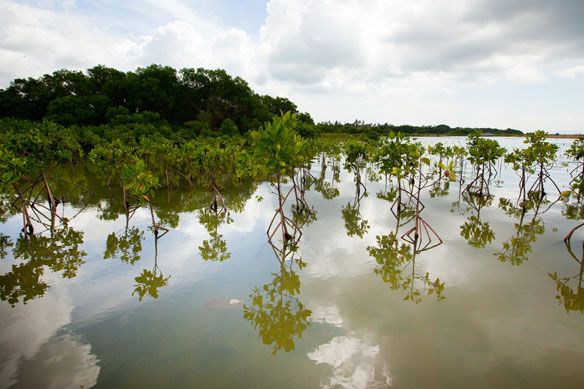
Mangroves in Bali are a vital part of the coastal ecosystem. The removal of large areas of mangroves for industrial purposes can significantly alter these precious coastal ecosystems. This can have a broader effect on the community, threatening vital clean water sources, tourist industries and the food supplies on which we rely. In addition to this, the root system of a mangrove forest serves to stabilize the coastline, providing protection from storm surges. Being a small archipelago made up of 17,000 islands, Indonesia is particularly vulnerable to rising sea levels or intense tropical storms linked to Global Warming. Captions and Photo source: Lawrence Hislop / UNEP
Excerpts;
Destruction of coastal habitats may release as much as 1 billion tons of carbon into the atmosphere each year, 10 times higher than previously reported, according to a new Duke-led study…
Read Full Article, Science Daily
Study: “Estimating Global “Blue Carbon” Emissions from Conversion and Degradation of Vegetated Coastal Ecosystems” PLoS One
Recent attention has focused on the high rates of annual carbon sequestration in vegetated coastal ecosystems—marshes, mangroves, and seagrasses—that may be lost with habitat destruction (‘conversion’). Relatively unappreciated, however, is that conversion of these coastal ecosystems also impacts very large pools of previously-sequestered carbon. Residing mostly in sediments, this ‘blue carbon’ can be released to the atmosphere when these ecosystems are converted or degraded. Here we provide the first global estimates of this impact and evaluate its economic implications…
Earth’s oceans and ecosystems absorb about half the greenhouse gases emitted by people, NOAA
Earth’s oceans, forests and other ecosystems continue to soak up about half the carbon dioxide emitted into the atmosphere by human activities, even as those emissions have increased..
Blue Carbon Initiative: Buried Treasure For Climate and Coastal Communities, UNEP
Dubbed “blue carbon” for their ability to sequester and store huge amounts of carbon, mangroves, seagrasses, and salt marshes- show great climate mitigation potential, immediately available and cost-effective, for removing greenhouse gases already in the atmosphere. The Blue Carbon Initiative program, draw the world’s attention to the crucial role of these direly threaten coastal ecosystems, in the fight against carbon emissions.









